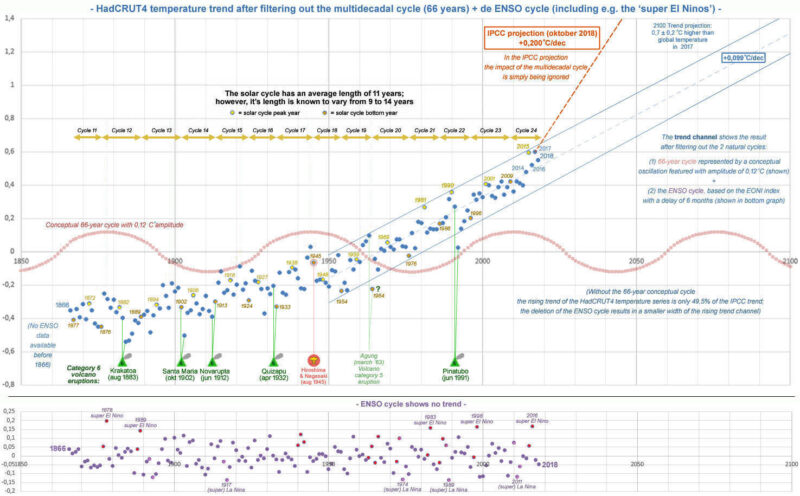Guest contribution by Martijn van Mensvoort

Warming on top of a conceptual 66-year cycle with an amplitude of 0.12°C (see the oscillating sine wave) after removal of the ENSO cycle; the ENSO cycle is shown in the lower part of the illustration. The most important volcanic influences are also featured + the influence of the sunspot cycle is made visible as well inside the upwardly directed trend channel.
Abstract
As early as 2004 the scientific literature recognizes that an extension of the definition for the climate from “minimum 30 years” to “minimum 50 years” is necessary because of the natural variability. Since at least 2012, Dutch KNMI researchers have publicly acknowledged that a 30-year period is too short for studying weather extremes in the context of climate change.
This article describes why a doubling to at least 60 years for the described duration in the definition of climate is desirable; this finding is based on the impact of the ENSO cycle + a 66-year cycle in the HadCRUT4 temperature series. The ‘satellite-era’ only started 40 years ago in 1979; the question now arises as to whether technology may even become an obstacle to actively avoiding overestimating both trends in global warming and the impact of CO2. For the time being, the old paradigm in the definition of the climate concerning the duration of “at least 30 years” seems to indicate that within this branch of science a ‘consensus’ is being used based on outdated principles. This report demonstrates how the structural impact of global warming is being overestimated by the IPCC by about a factor of 2 due to the use of an approach based on a too short analysis period.
Samenvatting
Op basis van natuurlijke variabiliteit wordt in de wetenschappelijke literatuur al sinds 2004 herkend dat een oprekking in de definitie voor het klimaat van “tenminste 30 jaar” naar “tenminste 50 jaar” noodzakelijk is. Door onderzoekers van het KNMI wordt sinds 2012 inmiddels erkend dat de periode van 30 jaar te kort is voor het bestuderen van weerextremen in het perspectief van klimaatverandering. In dit artikel wordt op basis van de combinatie van de ENSO cyclus en een 66-jarige cyclus m.b.v. de HadCRUT4 temperatuur serie beschreven waarom een verdubbeling naar tenminste 60 jaar voor de beschreven tijdsduur in de definitie van klimaat gewenst is. In het perspectief van het ‘satelliet tijdperk’ dat pas 40 jaar terug in het jaar 1979 is begonnen, ontstaat hierbij de vraag of technologie mogelijk zelfs een obstakel is gaan vormen om actief te vermijden dat zowel de trends in de opwarming als de impact van CO2 worden overschat. Voorlopig lijkt het achterhaalde paradigma in de definitie van het klimaat betreffende de tijdsduur van “tenminste 30 jaar” een indicatie dat binnen deze tak van wetenschap wordt gewerkt met een ‘consensus’ op basis van achterhaalde principes. In het vervolg wordt aangetoond dat de structurele impact van de trend in de opwarming wereldwijd door het IPCC met ongeveer een factor 2 wordt overschat t.g.v. het gebruik van een benadering die is gebaseerd op een te korte analyse periode.
Introduction
In November 2018, the KNMI described that the extremely hot years of 2015 and 2016 were largely caused by the internal variability of the climate through the emergence of the “strong El Nino”. According to NASA, the contribution of the ‘super El Nino’ to the average temperature worldwide for the year 2016 was approximately 0.16°C 5. The El Nino effect causes a net cooling of the ocean system and is characterized by the release of large amounts of heat and CO2 in the atmosphere7. The El Nino Southern Oscillation [ENSO] also appears to have a major impact on the annual growth of CO2 in the atmosphere; experts have estimated that the ‘super El Nino’ in 2016 contributed 25% of the growth of CO2 in the atmosphere. In a broader context, Henry’s law describes that the warming of the ocean water itself has contributed close to ~15% to the growth of CO2 in the atmosphere. Moreover, it has very recently become clear that in recent decades the ocean has also been responsible for up to 40% of the variability of CO2 in the atmosphere; climate models, on the other hand, assume that variability is mainly due to vegetation on the mainland12.
An earlier report in june 2019 demonstrates on the basis of the HadCRUT4 temperature series that ‘global warming’ is overestimated if the natural variability related to a 70-year cycle in the ocean system is not taken into account. This new report shows below that the multidecadal cycle is featured with a length of 66 years. A comparison between the 1970s, 1990s and 2010s shows that the assumed acceleration in global warming can almost entirely be attributed to the 66-year cycle. The 66-year cycle + the ENSO cycle combined appears to be responsible for more than 81% of the acceleration of the warming based on the 30-year average since the 1970s, and for more than 69% compared to the 1990s. Both natural cycles combined also largely explain the correlation between CO2 and temperature in the 21st century; ‘super El Ninos’ play a major role in this. This results in an overestimation of the impact of global atmospheric CO2 as well; this also applies to the acceleration with regard to the warming of the north pole.
After removal of the 66-year cycle (+ the ENSO cycle), an upwardly directed trend channel remains with an average temperature rise of approximately +0.09°C per decade that has now lasted about 70-90 years. This concerns less than half the expectation of +0.20°C per decade that the IPCC uses for the coming decades. Also, a projection has been made for the year 2100 from which it appears that based on the trend channel a temperature rise of +0.2°C to +0.9°C compared to the record year 2016 can be taken into account. A mix of factors plays a role in the emergence of the trend channel, such as: the growth of the world population, less use of sulphates (aerosols), changes in land use, use of greenhouse gases, and possibly a natural cycle of 200+ years (in the scientific literature this very long cycle is known as the Suess/de Vries cycle, which is related to the sunspots cycle). Since the 2nd half of the 1960s, a slight increase in ‘total solar radiation’ has had a small share in the creation of the trend channel.
An overestimation of the temperature by a factor of 2 due to natural variability can possibly imply that the impact of CO2 and other greenhouse gases is also overestimated by the IPCC with an impact of the same order.
For further reading
CONTENTS
• I – A 66 year cycle with an upward and downward phase of 33 years
• II – Warming on top of cycle shows stable trend channel
• III – Projection for the year 2100: 0.2-0.9°C on top of record year 2016
• IV – Annual growth CO2 correlates highly with ENSO cycle
• V – 21st century: correlation temperature-CO2 based on 66-year cycle & super El Nino
• VI – 21st century: warming rate 69% lower after removal of 66-year cycle & El Nino
• VII – 30-year average: acceleration in warming almost fully explained by 66-year cycle
• VIII – Four characteristics of the 66-year cycle
• IX – Five characteristics of the warming on top of the 66-year cycle
• X – 66-year cycle may have a cosmic origin
• XI – Is the definition of ‘climate’ outdated?
• XII – Discussion & conclusion
MSc/BEng Martijn van Mensvoort
education background:
Leiden University
MSc Clinical & Health Psychology [Drs. Klinische & Gezondheidspsychologie]
1993 – 1997
Hogeschool Eindhoven (Fontys)
BEng Technical Physics [Ing. Technische Natuurkunde]
1989 – 1993

Dear Martijn, nice study. I thought that the sun spot activity has an 11 years cycle as you have mentioned but also an other much longer cycle that resulted in a 50 year increased activity period that started around 1980 ? Are you aware of that?
Hi Frans,
I am aware of the following solar cycles:
– Schwabe Cycle or sunspot cycle (about 11 years)
– Hale Cycle (about 22 years, based on magnetism)
– Gleissberg Cycle (about 88 years)
– Jose Cycle (about 179 years, based on the path of the sun around the Barycenter)
– Suess Cycle or De Vries Cycle (about 200 years)
However, I am not aware that any of these cycles bottoms around 1980; maybe you can elaborate on which specific sun cycle you have in mind Frans?
Beste Martijn, ik heb in de jaren ’80 en ’90 contact gehad met de zonen fysica groep uit Utrecht van prof. Zwaan als ik het goed heb. In die groep zaten ook dr. de Jager en dr. Rob Hammerschlag. Ik dacht uit mijn hoofd onthouden te hebben dat in die jaren de zon begonnen was aan een vijftig jaar durende hogere activiteiten periode. Blijkbaar heb ik dat niet goed onthouden en zag ik op internet een interview met Kees de Jager uit 2010 en een interview uit 2017 met Gullen: ” Het ziet ernaar uit dat er een zeldzame periode aankomt van extreem lage zonneactiviteit. Dat zegt doctor Michael Guillen, schrijver en voormalig docent fysica aan de universiteit van Harvard. ”
Vandaar.
Gr Frans
Thanks for sharing your memories Frans.
This TSI-index does show that since the 1980s in the low phases of the sunspot cycle the total solar irradiance level did became higher; actually, it even reached the highest level of the 20th century in the 2008 bottom – see:
http://lasp.colorado.edu/lisird/data/historical_tsi/
PS. The future will tells us whether the next bottom (2019/2020) can produce an even higher bottom, but this other chart from the same website does indicate that in first 8 months of 2019 TSI was still a bit higher relative to the last bottom in the year 2009:
h ttp://lasp.colorado.edu/data/sorce/total_solar_irradiance_plots/tim_level3_tsi_24hour_640x480.png
Dear Martijn, sorry for my last reply in Dutch. You mention TSI and that is also of interest. But what about the solar hot spot activities that produce solar- wind?
Frans, to me it appears that the impact of solar wind on earth’s climate is largely still a mystery; nevertheless, apparently it does appear to have a connection with the lower phase(s) of the solar spot cycle because solar wind is associated with the so-called aa index (which involves geomagnetism).
Climate models usually only include the impact total irradiance (TSI); however, I have the impression that the fundamentals of the solar magnetisme cycle are probably more important than TSI. Unfortunately, most climate models do not address the influence of the solar magnetism cycle – which involves 22,2 years (= a double solar spot cycle, which takes by average 11,1 years).
In the discussion at Climategate one of the respondents presented me the following interesting question:
‘Where does this 66-year cycle come from?’
During the past weeks I have found multiple clues which together suggest that the magnetic solar cycle is apparently involved – resulting from the movement of the sun around solar system gravity center: the so-called Bary center. E.g. I have found that the Jose cycle plays a major part in this and I have found a phenomenon which suggests that the 66-year cycle is created out of a cumulative series of solar events with multiple irregular 66-cycles cycles involved.
I am using the word ‘irregular’ here in the sense that associated events show a pattern with 66-years- or multiple times 66-years involved; this involves cooling constellations that follow each other also with 132 years (= 2×66), 198 (=3×66) and 264 years (=4×66) in between.
The cooling-events that I have identified happen when both the Jose cycle and the solar spot cycle have a bottom with no more than 2 years in between.
What I am describing here can be recognized to represent a phenomenon that has not been covered in the work of Scafetta; he does mention the ‘solar angular moment’ that is involved with the Jose cycle but it appears to me that for unknown reasons Scafetta has putten his attention on the solar velocity – which does not produce the effect that I have found associated with solar angular momentum).
PS. I hope I have managed to describe this well, but I realize that this all involves very advanced stuff. Anyway, I have found various phenomena that point in the direction of the solar magnetism cycle; these make it possible for me to describe the impact of the effect in a relatively simple manner. So, a new follow-up article on the 66-year cycle is in progress – which will also include a reference to a 1973 study where a 66,6 year cycle has been reported based on spectrum analysis.
See https://climatesense-norpag.blogspot.com/2018/10/the-millennial-turning-point-solar.html
Quotes
“When analyzing complex systems with multiple interacting variables it is useful to note the advice of Enrico Fermi who reportedly said “never make something more accurate than absolutely necessary”. My recent paper presented a simple heuristic approach to climate science which plausibly proposed that a Millennial Turning Point (MTP) and peak in solar activity was reached in 1991……………………. The empirical temperature data is clear. The previous millennial cycle temperature peak was at about 990. ( see Fig 3 in the link below) The recent temperature Millennial Turning Point was about 2003/4 ( Fig 4 in link below ) which correlates with the solar millennial activity peak at 1991+/. The cycle is asymmetric with a 650 year +/- down-leg and a 350 +/- year up-leg. The suns magnetic field strength as reflected in its TSI will generally decline (modulated by other shorter term super-imposed solar activity cycles) until about 2650…………………………….
See the Energy and Environment paper
The coming cooling: usefully accurate climate forecasting for policy makers.
http://journals.sagepub.com/doi/full/10.1177/0958305X16686488
and an earlier accessible blog version at
http://climatesense-norpag.blogspot.com/2017/02/the-coming-cooling-usefully-accurate_17.html See also the discussion with Professor William Happer at
http://climatesense-norpag.blogspot.com/2018/02/exchange-with-professor-happer-princeton.html
The establishment’s dangerous global warming meme, the associated IPCC series of reports ,the entire UNFCCC circus, the recent hysterical IPCC SR1.5 proposals and Nordhaus’ recent Nobel prize are founded on two basic errors in scientific judgement. First – the sample size is too small. Most IPCC model studies retrofit from the present back for only 100 – 150 years when the currently most important climate controlling, largest amplitude, solar activity cycle is millennial. This means that all climate model temperature outcomes are too hot and likely fall outside of the real future world. (See Kahneman -. Thinking Fast and Slow p 118) Second – the models make the fundamental scientific error of forecasting straight ahead beyond the Millennial Turning Point (MTP) and peak in solar activity which was reached in 1991.These errors are compounded by confirmation bias and academic consensus group think.”